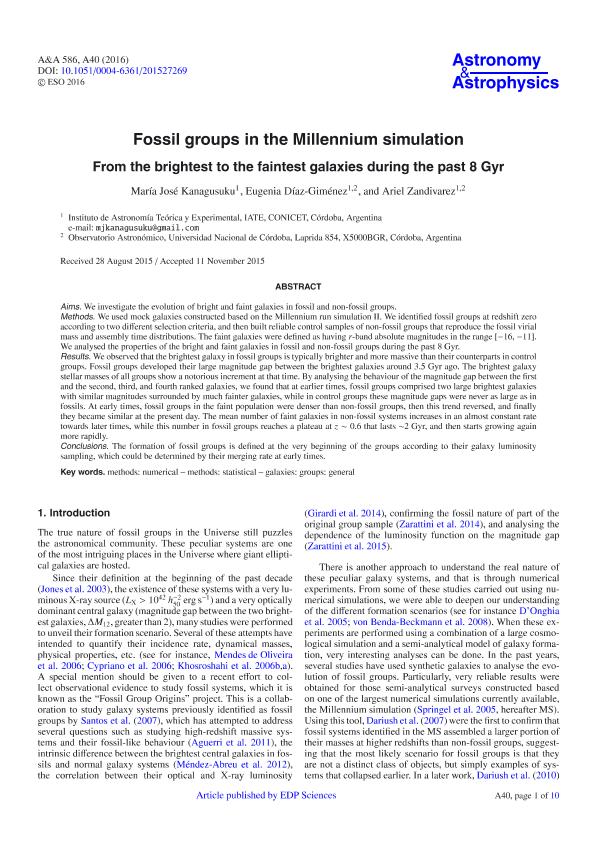Mostrar el registro sencillo del ítem
dc.contributor.author
Kanagusuku, Maria Jose

dc.contributor.author
Diaz, Maria Eugenia

dc.contributor.author
Zandivarez, Arnaldo Ariel

dc.date.available
2019-02-19T19:45:48Z
dc.date.issued
2016-02
dc.identifier.citation
Kanagusuku, Maria Jose; Diaz, Maria Eugenia; Zandivarez, Arnaldo Ariel; Fossil groups in the Millennium simulation: From the brightest to the faintest galaxies during the past 8 Gyr; EDP Sciences; Astronomy and Astrophysics; 586; 2-2016; 1-10; A40
dc.identifier.issn
0004-6361
dc.identifier.uri
http://hdl.handle.net/11336/70486
dc.description.abstract
Aims. We investigate the evolution of bright and faint galaxies in fossil and non-fossil groups. Methods. We used mock galaxies constructed based on the Millennium run simulation II. We identified fossil groups at redshift zero according to two different selection criteria, and then built reliable control samples of non-fossil groups that reproduce the fossil virial mass and assembly time distributions. The faint galaxies were defined as having r-band absolute magnitudes in the range [−16, −11]. We analysed the properties of the bright and faint galaxies in fossil and non-fossil groups during the past 8 Gyr. Results. We observed that the brightest galaxy in fossil groups is typically brighter and more massive than their counterparts in control groups. Fossil groups developed their large magnitude gap between the brightest galaxies around 3.5 Gyr ago. The brightest galaxy stellar masses of all groups show a notorious increment at that time. By analysing the behaviour of the magnitude gap between the first and the second, third, and fourth ranked galaxies, we found that at earlier times, fossil groups comprised two large brightest galaxies with similar magnitudes surrounded by much fainter galaxies, while in control groups these magnitude gaps were never as large as in fossils. At early times, fossil groups in the faint population were denser than non-fossil groups, then this trend reversed, and finally they became similar at the present day. The mean number of faint galaxies in non-fossil systems increases in an almost constant rate towards later times, while this number in fossil groups reaches a plateau at z ~ 0.6 that lasts ~2 Gyr, and then starts growing again more rapidly. Conclusions. The formation of fossil groups is defined at the very beginning of the groups according to their galaxy luminosity sampling, which could be determined by their merging rate at early times.
dc.format
application/pdf
dc.language.iso
eng
dc.publisher
EDP Sciences

dc.rights
info:eu-repo/semantics/openAccess
dc.rights.uri
https://creativecommons.org/licenses/by-nc-sa/2.5/ar/
dc.subject
Galaxies: Groups: General
dc.subject
Methods: Numerical
dc.subject
Methods: Statistical
dc.subject.classification
Astronomía

dc.subject.classification
Ciencias Físicas

dc.subject.classification
CIENCIAS NATURALES Y EXACTAS

dc.title
Fossil groups in the Millennium simulation: From the brightest to the faintest galaxies during the past 8 Gyr
dc.type
info:eu-repo/semantics/article
dc.type
info:ar-repo/semantics/artículo
dc.type
info:eu-repo/semantics/publishedVersion
dc.date.updated
2019-02-15T14:38:33Z
dc.journal.volume
586
dc.journal.pagination
1-10; A40
dc.journal.pais
Francia

dc.journal.ciudad
Paris
dc.description.fil
Fil: Kanagusuku, Maria Jose. Consejo Nacional de Investigaciones Científicas y Técnicas. Centro Científico Tecnológico Conicet - Córdoba. Instituto de Astronomía Teórica y Experimental. Universidad Nacional de Córdoba. Observatorio Astronómico de Córdoba. Instituto de Astronomía Teórica y Experimental; Argentina
dc.description.fil
Fil: Diaz, Maria Eugenia. Consejo Nacional de Investigaciones Científicas y Técnicas. Centro Científico Tecnológico Conicet - Córdoba. Instituto de Astronomía Teórica y Experimental. Universidad Nacional de Córdoba. Observatorio Astronómico de Córdoba. Instituto de Astronomía Teórica y Experimental; Argentina
dc.description.fil
Fil: Zandivarez, Arnaldo Ariel. Consejo Nacional de Investigaciones Científicas y Técnicas. Centro Científico Tecnológico Conicet - Córdoba. Instituto de Astronomía Teórica y Experimental. Universidad Nacional de Córdoba. Observatorio Astronómico de Córdoba. Instituto de Astronomía Teórica y Experimental; Argentina
dc.journal.title
Astronomy and Astrophysics

dc.relation.alternativeid
info:eu-repo/semantics/altIdentifier/url/https://www.aanda.org/articles/aa/abs/2016/02/aa27269-15/aa27269-15.html
dc.relation.alternativeid
info:eu-repo/semantics/altIdentifier/doi/http://dx.doi.org/10.1051/0004-6361/201527269
dc.relation.alternativeid
info:eu-repo/semantics/altIdentifier/url/https://arxiv.org/abs/1511.05978
Archivos asociados
